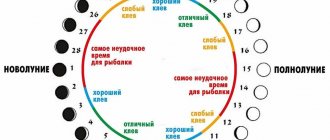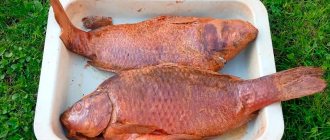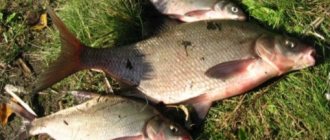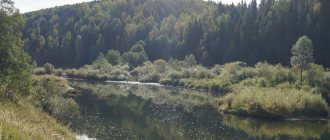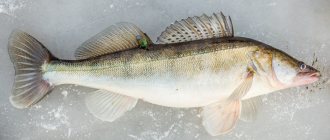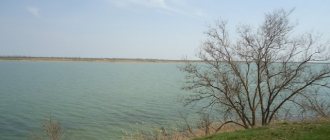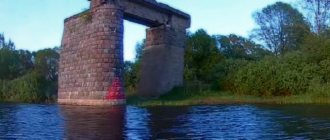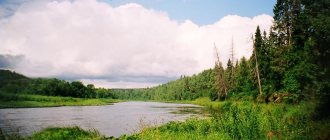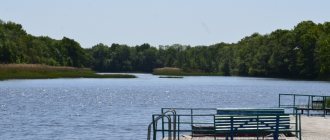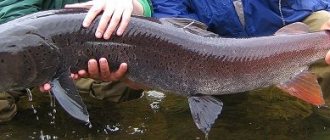Andrey Desyatov | June 3, 2021
In the Vologda region, fish such as asp, chub and ide are not numerous and their distribution area is small. And to catch them on Mologa with a spinning rod, you have to try hard. But real fishermen don’t look for easy ways!
“Ide is the fish of my dreams!” At one time, a video with that name from a Vologda amateur fisherman simply blew up the Internet - in the first two weeks after its release, it was viewed by more than seven million people. I won’t say that this is my dream either, but I like catching ide on Mologa, which is what I do with pleasure throughout the season. Previously, all this happened a little spontaneously - so, when hunting for chub with “micro-oscillators”, I came across ides along the way, as well as when catching pike with wobblers, and the “spinners” were not spared by the ide. But I didn’t focus on this - well, I pecked and pecked, it happens... But when I decided to delve into the intricacies of purposefully catching this red-finned fish with a spinning rod, I was seriously hooked.
Tackle
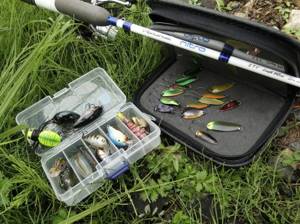
We will need, by and large, the same gear as when fishing for chub, because... The baits are mostly identical - I have “micro-oscillators” of up to 4 grams and small crank-shaped wobblers up to 50 mm long (photo 1) . The most important criterion when choosing a fishing rod is how well it copes with delivering a relatively light bait to the point where the fish are supposed to be staying. It must be taken into account that the ide, like the chub, does not like to be allowed within arm's length, as they say.
Taking into account the fact that fishing takes place on a flat river and its banks are most often open and quite accessible (photo 2) , I settled on a light rod 243 cm long with a test weight from 2 to 12 g. This spinning rod can easily cope with casting baits from three grams , if you use thin cords. According to the Asian classification, these will be “threads” # 0.4 - 0.5 PE (diameter approximately 0.104 - 0.117 mm) and are better than eight-strand weaving, because they are rounder and smoother, due to which the bait’s reach is better.
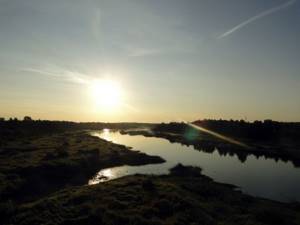
This thickness is enough to catch almost any fish; the main thing is to set the clutch correctly. The main requirement for a reel (mine is a two-thousandth one) is that it copes well with laying such a plan of cords.
Features of fishing on Mologa
Mologa is a river, fishing on which also leaves many positive emotions.
The ichthyofauna of the Mologa is generally typical for a river in temperate Russia. Here you can find perch, pike, dace, bream and ide, roach and asp, rudd and other species of fish. If you're lucky, you can also catch burbot, carp, catfish or round goby. The size of the fish directly depends on the spring water level of the river.
You can fish on Molog using different methods. But, according to experienced fishermen, the best method here is spinning fishing. This method is preferred by many, because it successfully combines sport and aesthetics, passion and science. In addition, spinning opens up wide opportunities for fisherman for various kinds of experiments and inventions.
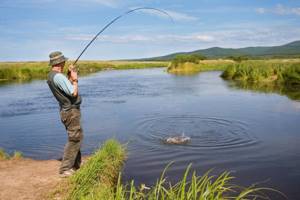
Perch, ide, asp and pike are the types of fish that may interest a spinning fisherman here. Those who prefer a fishing rod can try fishing for roach, dace or bream on Mologa. You can use peas, canned corn or regular earthworms as bait.
Fishing places
Where can you look for roach on the river in summer and early autumn? Of course, in the current, and the stronger it is, the better. And the strongest current is on Mologa in the area of rapids. It is desirable that the bottom be rocky, plus I look for places with islands of grass (photo 3) , and I have never caught a roach on sandy rifts with rare boulders.
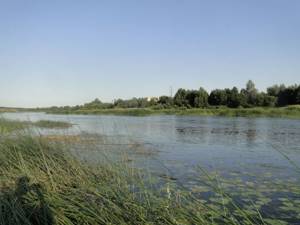
It is believed that ide and chub do not get along very well in the same section of the river, preferring different habitats and feeding areas. So, on my favorite river this is not so pronounced, and catching both at the same point is not a problem. But I got the impression that often schools of these fish change each other on the rifts. After catching five chubs, for example, in the next hour you can catch five roaches in a row, and vice versa.
You need to check the roll completely - the entrance to it, the roll itself and the exit. Flocks of roaches migrate more than once even during the day. And there is no clear time reference for where to look for it in the morning, afternoon or evening. In good warm weather it can be detected visually, you just need to look carefully at the surface of the water - the way it picks up something from the surface is quite noticeable. But here’s the method with bread crusts (I’ve already talked about this before, but let me remind you: at the beginning of the roll, we scatter them and see where the fish starts eating the crusts, which will determine the anchorage at the moment), which works with chub, does not work with ide.
In addition to the riffles, I came across tongues in other sections of the river. But these areas always had a pronounced current, but in slow water there were no bites. This, of course, does not mean that the ide is not there, but active fish, wanting to refresh themselves, often stand in the current. By the way, guys I know sometimes catch it well along the border of coastal water lilies.
Mologa River: rafting
The impossibility of quality navigation is not a reason not to kayak along the river. Fans of extreme and active recreation will gladly seize this idea.
The Mologa River is popular among raftsmen. Seeing boats and kayaks with tourists on its waters is not a rare occurrence. Rafting along the Mologa will be remembered for a long time, and most likely you will want to repeat the trip.
Going down the river, you will discover beautiful views that will not leave anyone indifferent. The most popular place for rafting is the section starting from the village of Maksatikha and ending near the city of Pestovo. The river here is narrow and winding, and what else is needed for quality rafting?
Rafting in this area is comfortable; there are no dams, destroyed bridges or rapids here. There are no rapids on Mologa at all, so you can safely go on a trip.
After an exhausting swim, you can relax in the shade of pine forests, where all tourists like to set up their camps. A particularly convenient coastline is on the left side - it is more flat. But the right bank also has its own charms. For example, an extraordinary view of the opening panorama!
Lures
I repeat, I use the same baits as when catching chub. In lures, tongues, like chubs, clearly prefer Japanese production - all kinds of Smith and Forest (photo 4) . But for some reason they are not satisfied with Crazy Fish We select the size and weight of the spoon used depending on the fishing area, the depth and strength of the current, remembering that the spoon should go deep and not go along the surface. Therefore, most often the compactness of the bait comes first. I know that some people regularly catch tongues even on Kuusamo Rasanen, but my spinners in this size are still silent.
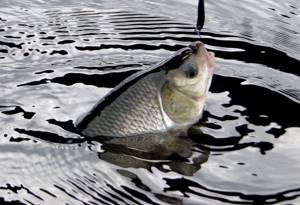
I can’t help but mention the “turntables”. True, I don’t catch them myself, but still. Fans of white predators, for the most part, use baits of sizes 0, 1 and 2 when catching average fish (not trophy fish) in our region. But there is a nuance - they use baits with a weighted core and work stably in the stream. According to reviews, the Swedish Myrans have proven themselves to be excellent. Roaches also like the “fly” on the tee, even if it is knitted from ordinary red woolen thread - this gives a much greater chance of a bite.
Roaches prefer wobblers that are quite voluminous, with a pronounced “game” of their own (photo 5) . It is better to leave small twitching minnows at home when fishing for it. I use several versions of deepening, starting from surface ones (SSR marking) and reaching deeper ones (MDR) , but I simply have nowhere to use the deepest versions.
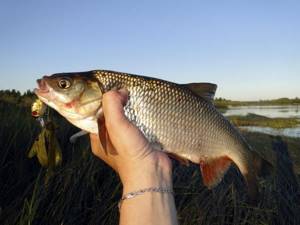
If the bait does not hold the stream, it begins to twist and is thrown to the surface, and bending the bow loop and adjustments do not help, then we can immediately abandon it, it is not suitable for us. If we paraphrase the formula “Stability is a sign of skill”, then we get “Stable “game” - every chance of a bite.”
Having looked at my statistics, at the moment I can identify three wobblers that are “ahead of the rest.” These are Baby Red Rag 32F SR and Hypnose 38F SR from Pontoon 21 and a handmade bait from the Ukrainian master “Tadpole-1” (photo 6) .
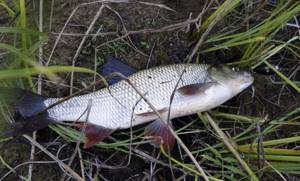
In my opinion, it is preferable to use dark or natural colors; ide, unlike perch and pike, is not so susceptible to “acid”. The same applies to spinners, which I completely forgot to write about.
When catching roaches, the real problem for me was the presence of hungry pike in the riffles - in the last fishing alone they cut off six (!) wobblers. It would seem that there is nothing complicated here - we put a leash, and there are no problems. But as soon as you tie it, the tongues stop pecking, completely. Either they see it, or even the most careful leashes affect the quality of the “game” of the bait. I tried the thinnest titanium ones, knitted ones and homemade ones from soft leash materials with minimal load - still it doesn’t want to! Someone will ask, why not use fluorocarbon leashes?
After all, they are also invisible in the water, which will be an additional advantage when catching cautious fish. The answer here is the most banal: because fluorocarbon in adequate diameters with delicately assembled gear does not provide any guarantee against pike teeth. She bites leashes with a diameter of 0.3 - 0.35 mm, my dear, once or twice, and tying thicker ones is a dubious decision. So you have to use exclusively the smallest and most accurate fasteners, matching their breaking load to your cord.
Continuation of the banquet
Fishing on the river in spring is a pleasure. There is enough time, as I wrote above, for more than one type of fishing, the weather is favorable, there is no need to wrap yourself in several sheepskin coats and carry felt boots.
The main thing is not to forget to take off your hat and expose your neck, so that you don’t come home with an uneven tan on your face, otherwise there were cases in my student days when the whole school admired my mountain tan and white forehead for a month.
In addition to the three listed types of fishing, which I have been purposefully practicing on Mologa in recent years, I also had fun catching other types of fish. For example, ruff.
But that was a long time ago. Eh, there was such a bite that with the simplest gear, filling a can in a few hours was not a problem.
In the spring, good roach is often caught in the by-catch of live bait, and good chubs also “fly in,” which, due to their tenacity on the fishing line, give a head start to many fish, often cutting the fishing line on the edge of the hole or simply breaking it off.
Dace and bleak appear. In a word, the river begins to come to life after the dead winter and pleases with bites of all kinds of its representatives.
This is how it is, fishing on your favorite river from the spring ice. But the time is not far off when the ice will break with noise and crackling noise, the river will overflow its banks, flooding fields and meadows, will wash away the dirt that has accumulated since the fall from its banks, and will gradually begin to calm down.
In the spring sun, the water will gradually warm up and brighten. And a completely different fishing will begin - in open water.
Fishing with float rods and feeder gear, which were finally legalized during the period of spawning bans.
Tactics for catching riffles
I definitely haven’t seen anything tricky here yet. I make all casts almost perpendicular to the current - and evenly, at an extremely slow speed, I move the bait. Casting upstream, in my opinion, is not necessary at all, because... The wiring turns out to be very fast, which would be more suitable for catching asp.
I don’t use all kinds of wiring like upstream, stop-and-go, twitching and so on, I just don’t see the point in them at the moment. For me, it’s better to thoroughly break through the entire riffle and understand in which part of it the active fish are now located. And when it is found, we simply start sorting through the baits in the box - as a rule, at least something will work, be it a small wobbler or a “micro-oscillator”.
Fishing time
So far, I am inclined to believe that the roach catches better in the afternoon, late afternoon and in the pre-sunset hours. In good weather, it can be active all day, but morning dawns are not always active. But when the sun is already higher, he wakes up.
But there is a time when catching it is simply useless, if only to test your nervous system for strength. I'm talking about the period of mass emergence of mayflies (photo 7) ! Several times in the evening I watched the “bel” feasting on the rifts, an incredible amount of it collected there, but artificial baits were completely ignored, although sometimes you felt a spinner running down someone’s back...

The day after departure there was also nothing to do on the river - in the sense of searching for a white predator. Bloodworms float on the surface, accumulate on reeds - in general, the fish have something to feast on besides iron or plastic.
You can successfully catch roaches and ides all summer and early autumn. My last catches were dated back to October, when I had to wear a winter suit jacket when fishing. I will try to conduct experiments on fishing in deeper autumn this year. Many people say that the closer autumn is, the brighter the predatory tendencies of the ide. So we'll see if it doesn't all slide down to the lower reaches of the river for the winter.

Ghost town of Mologa
When talking about this river, one cannot fail to mention the ghost town of Mologa.
Mologa was founded in 1777. The city was flooded in the 30s of the twentieth century by the waters of the Rybinsk Reservoir. At that time its population was at least 7 thousand people.
Construction of the Rybinsk hydroelectric complex began in 1935. At first it was planned that the flood level would be 98 meters above sea level (Mologa was located at this height), but later this parameter was increased by four meters. Thus, the city was completely under the water of the river.
In total, about 130 thousand residents were evicted from the flood zone. The eviction lasted for almost 4 years. Most of the displaced ended up in the village of Slip, near Rybinsk.
Since the early 70s, residents of the former Mologa gather annually to honor the memory of their hometown. Although this was strictly prohibited in Stalin’s times, the authorities tried to erase the flooded city even from people’s memory.
An amazing event happened in 2014, in the summer. The water level in the artificial sea dropped significantly, and part of the once flooded city found itself on the surface. In particular, one could see the walls and foundations of houses, the city cemetery and even entire streets of Mologa. In connection with these events, the community of former residents of Mologa decided to visit the ruins of their hometown.
